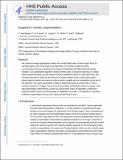Keypoint Transfer Segmentation
Author(s)
Toews, M.; Wachinger, Christian; Langs, Georg; Wells, William M; Golland, Polina
DownloadKeypoint Transfer Segmentation.pdf (1.010Mb)
OPEN_ACCESS_POLICY
Open Access Policy
Creative Commons Attribution-Noncommercial-Share Alike
Terms of use
Metadata
Show full item recordAbstract
We present an image segmentation method that transfers label maps of entire organs from the training images to the novel image to be segmented. The transfer is based on sparse correspondences between keypoints that represent automatically identified distinctive image locations. Our segmentation algorithm consists of three steps: (i) keypoint matching, (ii) voting-based keypoint labeling, and (iii) keypoint-based probabilistic transfer of organ label maps. We introduce generative models for the inference of keypoint labels and for image segmentation, where keypoint matches are treated as a latent random variable and are marginalized out as part of the algorithm. We report segmentation results for abdominal organs in whole-body CT and in contrast-enhanced CT images. The accuracy of our method compares favorably to common multi-atlas segmentation while offering a speed-up of about three orders of magnitude. Furthermore, keypoint transfer requires no training phase or registration to an atlas. The algorithm’s robustness enables the segmentation of scans with highly variable field-of-view.
Date issued
2017-08-02Department
Massachusetts Institute of Technology. Computer Science and Artificial Intelligence LaboratoryJournal
Information Processing in Medical Imaging
Citation
Wachinger, C.; Toews, M.; Langs, G.; Wells, W. et al. “Keypoint Transfer Segmentation.” Information Processing in Medical Imaging (2015): 233–245 © Springer International Publishing Switzerland 2015
Version: Author's final manuscript
ISBN
978-3-319-19991-7
978-3-319-19992-4
ISSN
0302-9743
1611-3349